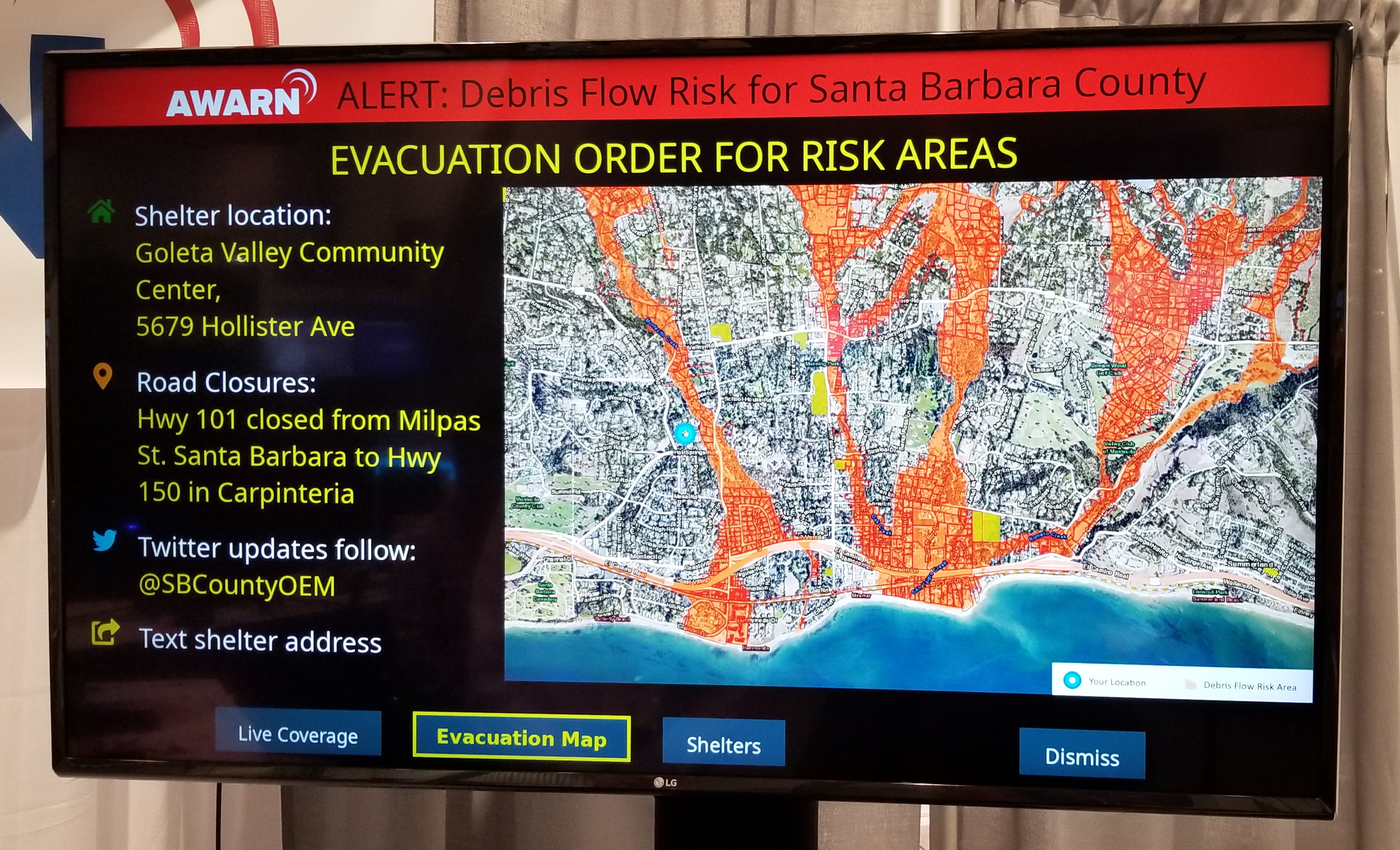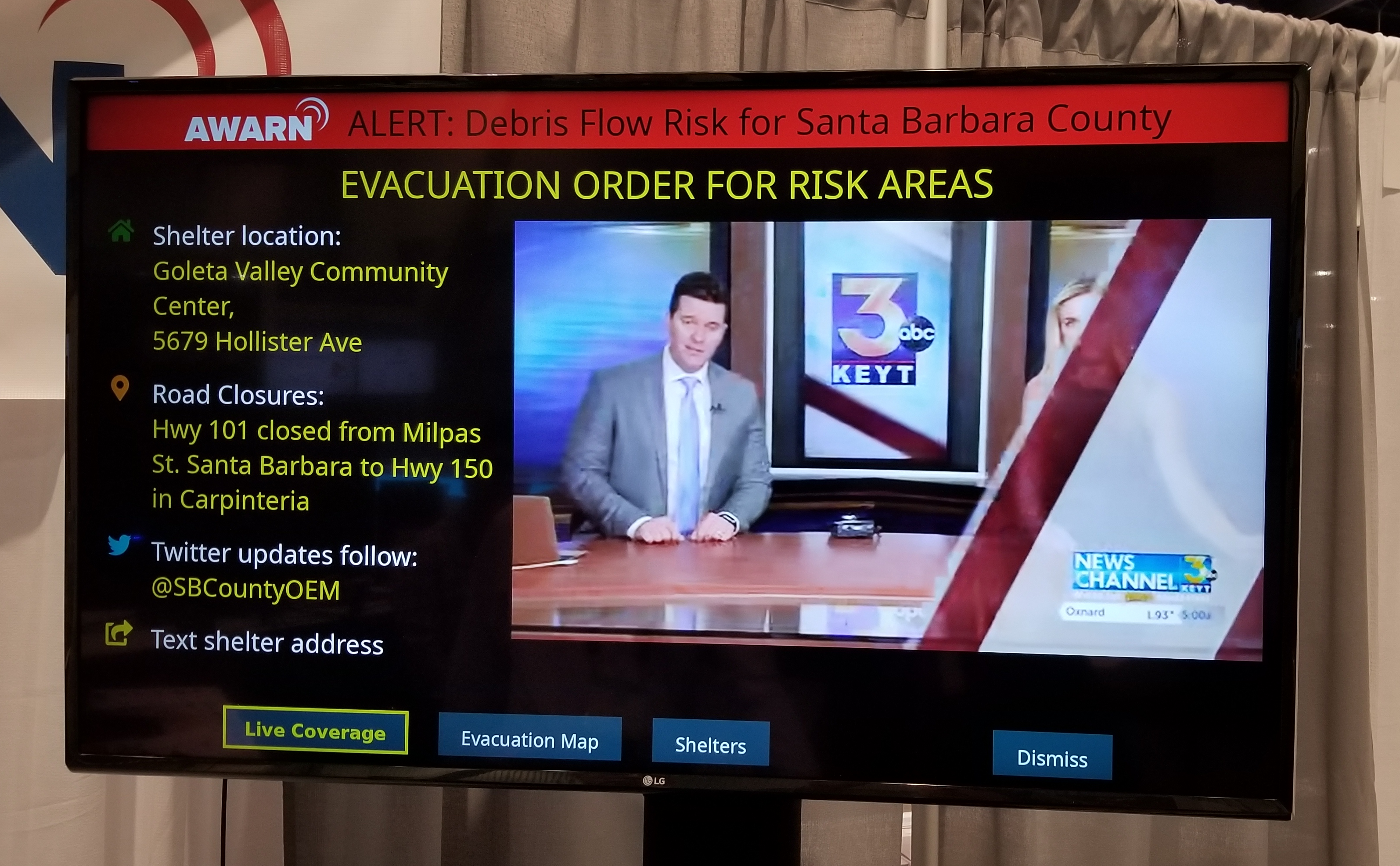ATSC 3.0 Emergency Alerting, Information Make Big Strides at NAB Show
LAS VEGAS—Advanced emergency alerting as part of ATSC 3.0 demonstrated at the recently concluded 2019 NAB Show has evolved into a tightly knit system, not restricted simply to the delivery of imminent threat warnings but also conveyance of useful emergency information.
However, on the consumer side of the equation, the show underscored that there is still work to be done. “At this stage in the game—and we are pre-commercial launch—not all 3.0 sets are fully loaded with software,” said Ed Czarnecki, senior director, Strategy & Government Affairs, at Digital Alert Systems.
A case in point was the glass-to-glass demonstration of ATSC 3.0 by Hitachi Kokusai Electric Comark. “We had some canned EAS messages in the [Digital Alert Systems] DASDEC that we were pushing to the Triveni Digital GuideBuilder XM,” explained Tim Hosmer, director of Comark Digital Services.
“What we discovered was that on our Samsung TV, the receiver app was not able to find those EAS messages,” he said. “So we could see them on the output of our [Triveni Digital] StreamScope Verifier but not on the TV.”
However, the inability of the set to recognize these messages says more about where 3.0 is in the process of becoming productized by consumer electronics manufacturers than anything else, said Czarnecki.

“This points to where the [consumer electronics] industry will have to go next in terms of harmonizing specifications and approaches for the actual display of the information on consumer TV sets,” said Czarnecki. “It’s not a bad place to be, given we are still pre-market [launch of 3.0 sets].”
Recommended practices defining what devices should do with the Advanced Emergency Alerting information payload are expected later this year from the Consumer Technology Association, he added.
Get the TV Tech Newsletter
The professional video industry's #1 source for news, trends and product and tech information. Sign up below.
On the broadcast side of the equation, the 2019 NAB Show pointed to the success vendors are having in developing interoperable systems to support AEA. “That’s one of the big things we are trying to show at the NAB Show this year,” said Czarnecki.
To that end, Comark featured a “glass-to-glass” 3.0 demonstration in its booth originating with a Hitachi DK-H200 studio camera through an all-in-one 3.0 hardware travel rack, including the CDS powered by TITAN Live (ATEM) encoder; Triveni GuideBuilder XM with ROUTE server option; Digital Alert Systems DASDEC feeding EAS messages; Enensys ATSC Scheduler; Triveni StreamScope and StreamScope Verifier; Comark EXACT V2 3.0 exciter; and Comark QoS 1000 RT layer monitor receiver.
UniSoft, working with several partners, including IBM’s The Weather Company, also transmitted live, over-the-air 3.0 with an emphasis on Advanced Emergency Alerting information.
Based on its UniRack, a Next-Gen TV station-in-a-box, the UniSoft system played out an HD signal from a BroadStream OASYS player, inserted Nielsen and Verance Aspect watermarking with a Linear Acoustic Aero 2000, encoded an HEVC stream with an ATEM TITAN encoder with DASH packager, and pushed the DASH segments to an S&T ATCaster Signaling Server where emergency information and alerts from a Digital Alert Systems’ DASDEC were received.
“The result of the ATCaster is several multicasts, which go straight to the scheduler that encapsulates them in ALP [ATSC Link-layer Protocol] packets and generates physical layer pipes through the STL to our preferred exciter, which is a Pro Television Exciter,” said UniSoft CTO Guy Hadland.
For the AEA demo, UniSoft transmitted on channel 24.2—one of three 3.0 channels, the others being a UHD channel and another HD channel—using a 10W transmitter from GatesAir. Samsung, LG Electronics and Sony television sets around the show floor, including those in the UniSoft and Digital Alert Systems booths, received the transmission.
For UniSoft’s demo, a Sony ATSC 3.0 consumer set, connected to a gateway receiver running an AEA receiver application, detected the presence of emergency information in the 3.0 signaling and pulled up radar scans of a hypothetical tornado warning affecting the Boston area provided by The Weather Company. Using the remote control, a viewer could request additional related emergency information, such as what to do in a tornado to stay safe, or dismiss the warning entirely.
“The AEA [Advanced Emergency Alerting] message is a very low-level [ATSC 3.0] service. It is one of the very first things a TV set receives and processes,” explained Czarnecki. “The receiver app is triggered by that AEA message and displays the text and—also through a feature like this—accesses the multimedia files that are being downloaded.”

The demo reflected the efforts of the emergency alerting community to develop the emergency information capabilities of ATSC 3.0, which permits viewers to choose to view rich media and textual information or dismiss the alert and continue watching regular programming without distraction.
“We have strongly encouraged all the parties to reposition the thinking on AEA, from Advanced Emergency Alerting to Advanced Emergency Information,” said Czarnecki. “The information being the broad spectrum of urgent information, community-related information that a broadcaster can present to its audience. That’s really taken ahold. That’s exciting.”
John Lawson, executive direction of the Advanced Warning and Response Network, delivered much the same message in the AWARN booth. “One direction we are taking is to go a step further and not just focus on alerting, but focus on aggregating a whole range of local news and information content that can be made available,” said Lawson.
This strategy is consistent with the desires of TV news managers and the emergency management community that have told Lawson that alerts should “only be used for the most severe and urgent” warnings, especially if the 3.0-based TV wakeup function is used, he said.
AEA Manager, a new product from Triveni Digital, powered the AWARN demo, said Ralph Bachofen, VP of sales and marketing of the company.
“It’s a studio tool that allows a high-level, canned interface for such alerting [AEA alerting] where you can just add information that will be encoded and put into that [AEA] environment,” he said.
Representatives of NAB’s PILOT initiative approached Triveni Digital about building the product to make it easy for newsrooms to leverage the emergency information aspect of AEA, thus providing 3.0 viewers with access to a wide variety of text- and rich-media-based content, such as evacuation routes, shelter locations and what to do in tornado, he added.
To demonstrate what is possible, Lawson showed how emergency information can be conveyed via 3.0 following an emergency. “It could be road closures or where to find generators,” he said. Eventually a small on-screen icon could show up on the screen to alert viewers that such information is available and give them access to it.
“If they don’t want to interrupt their programming, they don’t have to,” he said. “But if they click on it, there is an aggregation of content from public sources [and] non-profits. It could be weather, traffic [or] school closings.”
There is even a provision for a revenue model to sponsor this type of information that can be used “to fund continual improvement of the alerting function,” he said.
Another focus at the AWARN booth was the user experience (UX) of alerting. While still under development, the alert UX—designed by a creative executive from CNN—conveys in an instant that an alert is legitimate and issued by a bona fide source so that viewers react without delay, he said.
“They delay because they seek more information; they seek confirmation. It’s called milling. If we can cut that down, it will help,” Lawson explained.
Leveraging the geo-targeting capabilities with 3.0 should also help viewers to pay attention when an alert is issued. “Over-alerting is the biggest problem in alerting,” he said “With geo-targeting you can reduce that.”
To illustrate the power of geo-targeting, Lawson showed a map from the Santa Barbara (Calif.) County Office of Emergency Management. It illustrated various debris flows stemming from rains that followed the Thomas Fire of 2017. “It’s very important to put ‘You Are Here’ on the map,” he said. “We can do that, but there are still some implementation decisions [to be made].”
While such decisions remain as does the development of recommended practices for an AEA-enabled receiver app, there was a feeling of general accomplishment at the NAB Show about ATSC 3.0 and more specifically about the status of AEA.
That became evident to Czarnecki during NAB Show setup. “We put it all together, and things just worked,” he said. “We are taking theory into practice in very short order and showing people that ATSC 3.0 is ready for market—at least in terms of what we are doing—ready for market today.”
For a comprehensive source of TV Technology’s ATSC 3.0 coverage, see ourATSC3 silo.
Phil Kurz is a contributing editor to TV Tech. He has written about TV and video technology for more than 30 years and served as editor of three leading industry magazines. He earned a Bachelor of Journalism and a Master’s Degree in Journalism from the University of Missouri-Columbia School of Journalism.

